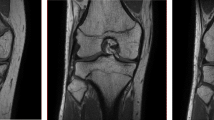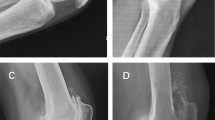Abstract
Age estimation of living individuals is a regular activity in medico-legal practice. Among the available tools for determining skeletal age, some authors have stated that the disappearance of epiphyseal scars could be a useful marker. The aim of the present study was to assess whether the presence of an epiphyseal scar on the knee, as seen on a plain X-ray, was linked to biological age. A total of 988 frontal X-rays of individuals (509 females and 479 males) aged between 15 and 40 years were analyzed to see whether a scar was visible or not on each of the three epiphyses of the knee. A scar was visible for 96 % of the females and 98 % of the males. For each sex, scars were visible at each year of age, from 15 to 40 years. In younger females, there were 15 individuals with no scar visible on the fibula, 16 on the tibia, and 20 on the femur. For males, the ages were respectively 16, 17, and 18 years. On a frontal X-ray, the persistence of epiphyseal scars was not a marker of a recent fusion. All individuals with fully ossified knee that had no scar on the femur were older than 18 years. Further studies focusing on epiphyseal scars on MR and CT scans could be useful, as these techniques allow the more precise analysis of the epiphysis.



Similar content being viewed by others
References
Cope Z (1920) Fusion-lines of bones. J Anat 55:36–37
Weiss E, DeSilva J, Zipfel B (2012) Brief communication: radiographic study of metatarsal one basal epiphyseal fusion: a note of caution on age determination. Am J Phys Anthropol 147:489–492
McKern TW, Steward TD (1957) Skeletal age changes in young American males, analysed from the standpoint of age identification. Headquarters Quatermaster Research and Development Command, Technical Report EP-45, Natick
Davis DA, Parsons FG (1927) The age order of the appearance and union of the normal epiphyses as seen by X-rays. J Anat 62(Pt 1):58–71
Paterson RS (1929) A radiological investigation of the epiphyses of the long bones. J Anat 64:28–46
Flecker H (1931) Roentgenographic observations of the times of appearance of epiphyses and their fusion with the diaphyses. J Anat 67(Pt1):118–164
Greulich WW, Pyle SI (1959) Radiographic atlas of skeletal development of the hand and wrist. Stanford University Press, Stanford
Hoerr NL, Pyle SI, Francis CC (1962) Radiographic atlas of skeletal development of the foot and ankle: a standard of reference. Charles C Thomas, Springfield
Pyle SI, Hoerr NL (1969) A radiographic standard of reference for the growing knee. Charles C. Thomas, Springfield
Schmeling A, Schultz R, Reisinger W, Mïhler M, Wernecke KD, Geserick G (2004) Studies on the time frame for ossification of the medial clavicular epiphyseal cartilage in conventional radiography. Int J Legal Med 118:5–8
Schulz R, Mühler M, Mutze S, Schmidt S, Reisinger W, Schmeling A (2005) Studies on the time frame for ossification of the medial epiphysis of the clavicle as revealed by CT scans. Int J Legal Med 119:142–145
O’Connor JE, Bogue C, Spence LD, Last J (2008) A method to establish the relationship between chronological age and stage of union from radiographic assessment of epiphyseal fusion at the knee: an Irish population study. J Anat 212:198–209
Kellinghaus M, Schultz R, Vieth V, Schmidt S, Schmeling A (2010) Forensic age estimation in living subjects based on the ossification status of the medial clavicular epiphysis as revealed by thin-slice multidetector computed tomography. Int J Legal Med 124:149–154
Kellinghaus M, Schultz R, Vieth V, Schmidt S, Pfeiffer H, Schmeling A (2010) Enhanced possibilities to make statements on the ossification status of the medial clavicular epiphysis using an amplified staging scheme in evaluating thin-slice CT scans. Int J Legal Med 124:321–325
Davies C, Hackman L, Black S (2014) The persistence of epiphyseal scars in the adult tibia. Int J Legal Med 128:335–343
Scheuer L, Black S (2000) Developmental Juvenile Osteology. Elsevier/Academic Press, Amsterdam
Dedouit F, Auriol J, Rousseau H, Rougé D, Crubézy E, Telmon N (2012) Age assessment by magnetic resonance imaging of the knee: a preliminary study. Forensic Sci Int 217:231.e1–232.e7
Krämer JA, Schmidt S, Jügens KU, Lentschig M, Schmeling A, Vieth V (2014) Forensic age estimation in living individuals using 3.0T MRI of the distal femur. Int J Legal Med 128(3):509–514
Schulz R, Mühler M, Reisinger W, Schmidt S, Schmeling A (2008) Radiographic staging of ossification of the medial clavicular epiphysis. Int J Legal Med 122:55–58
Wittschieber D, Ottow C, Vieth V, Küppers M, Schulz R, Hassu J, Bajanowski T, Püschel K, Ramsthaler F, Pfeiffer H, Schmidt S, Schmeling A (2014) Projection radiography of the clavicle: Still recommendable for forensic age diagnostics in living individuals? Int J Legal Med. doi:10.1007/s00414-014-1067-0
Wittschieber D, Schmeling A, Schmidt S, Heindel W, Pfeiffer H, Vieth V (2013) The Risser sign for forensic age estimation in living individuals: a study of 643 pelvic radiographs. Forensic Sci Med Pathol 9(1):36–43
Wittschieber D, Vieth V, Domnick C, Pfeiffer H, Schmeling A (2013) The iliac crest in forensic age diagnostics: Evaluation of the apophyseal ossification in conventional radiography. Int J Legal Med 127:473–479
O’Connor JE, Coyle J, Bogue C, Spence LD, Last J (2014) Age prediction formulae from radiographic assessment of skeletal maturation at the knee in an Irish population. Forensic Sci Int 234:188.e1–188.e8
Hackman L, Black S (2013) Age estimation from radiographic images of the knee. J Forensic Sci 58(3):732–737
Saint-Martin P, Rerolle C, Pucheux J, Dedouti F, Telmon N (2014) Contribution of distal femur MRI to the determination of the 18-year limit in forensic age estimation. Int J Legal Med. doi:10.1007/s00414-014-1020-2
Author information
Authors and Affiliations
Corresponding author
Rights and permissions
About this article
Cite this article
Faisant, M., Rerolle, C., Faber, C. et al. Is the persistence of an epiphyseal scar of the knee a reliable marker of biological age?. Int J Legal Med 129, 603–608 (2015). https://doi.org/10.1007/s00414-014-1130-x
Received:
Accepted:
Published:
Issue Date:
DOI: https://doi.org/10.1007/s00414-014-1130-x




